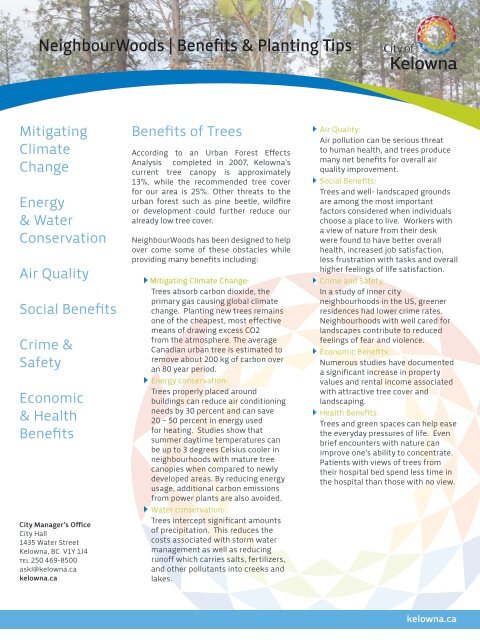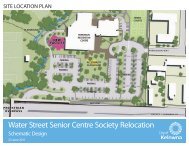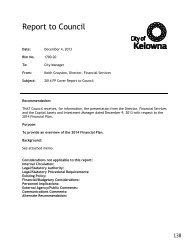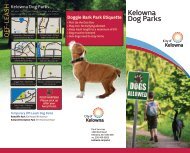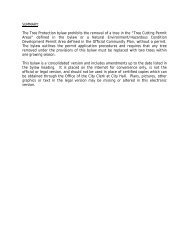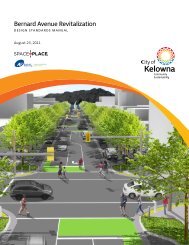NeighbourWoods - Benefits of Trees & Planting Tips - City of Kelowna
NeighbourWoods - Benefits of Trees & Planting Tips - City of Kelowna
NeighbourWoods - Benefits of Trees & Planting Tips - City of Kelowna
Create successful ePaper yourself
Turn your PDF publications into a flip-book with our unique Google optimized e-Paper software.
<strong>NeighbourWoods</strong> | <strong>Benefits</strong> & <strong>Planting</strong> <strong>Tips</strong><br />
Mitigating<br />
Climate<br />
Change<br />
Energy<br />
& Water<br />
Conservation<br />
Air Quality<br />
Social <strong>Benefits</strong><br />
Crime &<br />
Safety<br />
Economic<br />
& Health<br />
<strong>Benefits</strong><br />
<strong>City</strong> Manager’s Office<br />
<strong>City</strong> Hall<br />
1435 Water Street<br />
<strong>Kelowna</strong>, BC V1Y 1J4<br />
Tel 250 469-8500<br />
askl@kelowna.ca<br />
kelowna.ca<br />
<strong>Benefits</strong> <strong>of</strong> <strong>Trees</strong><br />
According to an Urban Forest Effects<br />
Analysis completed in 2007, <strong>Kelowna</strong>’s<br />
current tree canopy is approximately<br />
13%, while the recommended tree cover<br />
for our area is 25%. Other threats to the<br />
urban forest such as pine beetle, wildfire<br />
or development could further reduce our<br />
already low tree cover.<br />
<strong>NeighbourWoods</strong> has been designed to help<br />
over come some <strong>of</strong> these obstacles while<br />
providing many benefits including:<br />
Mitigating Climate Change:<br />
<strong>Trees</strong> absorb carbon dioxide, the<br />
primary gas causing global climate<br />
change. <strong>Planting</strong> new trees remains<br />
one <strong>of</strong> the cheapest, most effective<br />
means <strong>of</strong> drawing excess CO2<br />
from the atmosphere. The average<br />
Canadian urban tree is estimated to<br />
remove about 200 kg <strong>of</strong> carbon over<br />
an 80 year period.<br />
Energy conservation:<br />
<strong>Trees</strong> properly placed around<br />
buildings can reduce air conditioning<br />
needs by 30 percent and can save<br />
20 – 50 percent in energy used<br />
for heating. Studies show that<br />
summer daytime temperatures can<br />
be up to 3 degrees Celsius cooler in<br />
neighbourhoods with mature tree<br />
canopies when compared to newly<br />
developed areas. By reducing energy<br />
usage, additional carbon emissions<br />
from power plants are also avoided.<br />
Water conservation:<br />
<strong>Trees</strong> intercept significant amounts<br />
<strong>of</strong> precipitation. This reduces the<br />
costs associated with storm water<br />
management as well as reducing<br />
run<strong>of</strong>f which carries salts, fertilizers,<br />
and other pollutants into creeks and<br />
lakes.<br />
Air Quality:<br />
Air pollution can be serious threat<br />
to human health, and trees produce<br />
many net benefits for overall air<br />
quality improvement.<br />
Social <strong>Benefits</strong>:<br />
<strong>Trees</strong> and well- landscaped grounds<br />
are among the most important<br />
factors considered when individuals<br />
choose a place to live. Workers with<br />
a view <strong>of</strong> nature from their desk<br />
were found to have better overall<br />
health, increased job satisfaction,<br />
less frustration with tasks and overall<br />
higher feelings <strong>of</strong> life satisfaction.<br />
Crime and Safety:<br />
In a study <strong>of</strong> inner city<br />
neighbourhoods in the US, greener<br />
residences had lower crime rates.<br />
Neighbourhoods with well cared for<br />
landscapes contribute to reduced<br />
feelings <strong>of</strong> fear and violence.<br />
Economic <strong>Benefits</strong>:<br />
Numerous studies have documented<br />
a significant increase in property<br />
values and rental income associated<br />
with attractive tree cover and<br />
landscaping.<br />
Health <strong>Benefits</strong>:<br />
<strong>Trees</strong> and green spaces can help ease<br />
the everyday pressures <strong>of</strong> life. Even<br />
brief encounters with nature can<br />
improve one’s ability to concentrate.<br />
Patients with views <strong>of</strong> trees from<br />
their hospital bed spend less time in<br />
the hospital than those with no view.<br />
kelowna.ca
Water the tree<br />
for the first<br />
three years<br />
<strong>of</strong> establishment,<br />
about<br />
once a week<br />
during the<br />
growing season<br />
(more<br />
<strong>of</strong>ten during<br />
hot weather).<br />
Keep the soil<br />
moist but not<br />
soaked.<br />
The main reasons<br />
trees die<br />
after transplanting<br />
are<br />
underwatering,<br />
overwatering<br />
and<br />
when they are<br />
planted too<br />
deeply.<br />
Tree <strong>Planting</strong> <strong>Tips</strong><br />
This information is adapted from the<br />
International Society <strong>of</strong> Arboriculture.<br />
The ideal time to plant trees is during<br />
the dormant season (fall or early<br />
spring).<br />
Exercise care in storage and transport<br />
<strong>of</strong> nursery stock, to avoid stress or<br />
mechanical damage. Lift the tree by<br />
the root ball, not by the trunk. Do not<br />
allow roots to dry out.<br />
Before digging, locate all underground<br />
utility wires. Call (800) 474-6886.<br />
Please try to plant tree where it will<br />
shade your home.<br />
Dig a shallow, broad planting hole<br />
with the hole widest at the top and<br />
sloping sides; at least 450-600mm<br />
(18-24 in) wider than the root ball<br />
diameter (or 3-5 times wider than<br />
root ball diameter in compacted<br />
soils). Dig only to the same depth as<br />
the root ball. Identify the trunk flare<br />
(point where the roots spread at the<br />
base <strong>of</strong> the tree) to determine the<br />
proper depth <strong>of</strong> the hole.<br />
Water tree in pot. Remove the pot.<br />
Score and loosen the roots. Place the<br />
tree in the hole, at the proper height.<br />
Do not plant the tree lower than the<br />
trunk flare; it is better to plant a few<br />
inches higher than the trunk flare to<br />
allow for some settling.<br />
Straighten the tree and gently backfill<br />
the hole.<br />
When backfilling use the same<br />
soil that came out <strong>of</strong> the hole; if a<br />
different type <strong>of</strong> soil is used to fill<br />
the hole, this may result in problems<br />
with drainage around the root ball.<br />
If the native soil is extremely poor,<br />
topsoil or soil amendments may be<br />
necessary but mix at least 50% <strong>of</strong><br />
the native soil in with any additional<br />
amendments; topsoil should match<br />
the same texture as the native soil<br />
and the hole should be much wider to<br />
allow for growth.<br />
Firm the soil but do not pack. Water<br />
thoroughly. Remaining soil may be<br />
mounded into a berm to collect water<br />
in the root zone (leave a gap in the<br />
berm if the soil is clay). Fertilizer<br />
application at the time <strong>of</strong> planting is<br />
not recommended.<br />
Stake the tree only if necessary, as<br />
staked trees tend to develop weaker<br />
trunks and smaller root systems.<br />
Remove support staking after the<br />
first year <strong>of</strong> growth to avoid girdling<br />
the stem.<br />
Mulch the base <strong>of</strong> the tree with 50-<br />
100mm (2-4 in) <strong>of</strong> organic matter<br />
(e.g. straw, bark, peat moss, wood<br />
chips, leaf litter) to hold in moisture<br />
and protect against extreme soil<br />
temperatures. Keep mulch at least<br />
25-50mm (1-2 in) away from the trunk<br />
to prevent decay. Do not apply too<br />
much mulch.<br />
Water the tree for the first three years<br />
<strong>of</strong> establishment, about once a week<br />
during the growing season (more<br />
<strong>of</strong>ten during hot weather). Keep the<br />
soil moist but not soaked.<br />
Prune sparingly after planting;<br />
corrective pruning should not be done<br />
until the tree has experienced a full<br />
year <strong>of</strong> new growth.<br />
Tree spacing will vary depending<br />
upon the geometry <strong>of</strong> the site and<br />
landscaping objectives. Consider<br />
the volume <strong>of</strong> soil available to each<br />
tree. If the soil volume is too low<br />
(then trees will be competing with<br />
each other for available water and<br />
nutrients. Keep in mind the mature<br />
size <strong>of</strong> the tree so that tree canopies<br />
will not become too closely packed as<br />
they grow.<br />
The three main reasons trees die after<br />
transplanting are underwatering,<br />
overwatering and when they are planted<br />
too deeply.<br />
kelowna.ca


